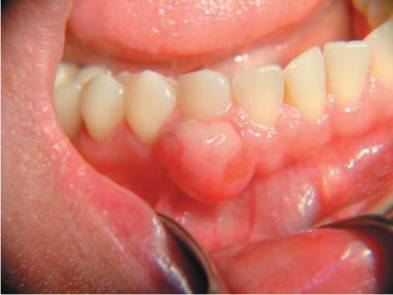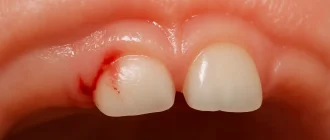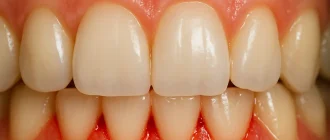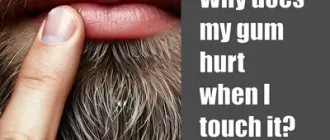The sensitive area known as the roof of the mouth can develop various types of spots and bumps for different reasons. While certain spots may pose no harm, others may necessitate medical attention. Thus, it is crucial to be aware of the potential causes and symptoms associated with these spots and bumps.
The roof of the mouth can develop different types of spots and bumps, including:
- Canker sores: Canker sores are tiny, superficial wounds that typically heal on their own in one to two weeks. They are not contagious and can be triggered by stress, physical injury, or specific foods.
- Cold sores: Cold sores are collections of fluid-filled blisters that have the potential to burst and release fluid before forming a crust. The herpes simplex virus is responsible for causing cold sores, which have a duration of up to a fortnight.
- Mucoceles: These are harmless, cyst-like growths that form when a salivary gland becomes obstructed or injured.
- Oral cancer: Symptoms of oral cancer can include the presence of spots and bumps on the roof of the mouth. These spots may be in the form of red or white patches that persist without disappearing as time goes on.
Torus Palatinus
Torus Palatinus overview and causes
Torus Palatinus is a bony growth that develops on the hard palate (roof of the mouth) and is typically harmless. The exact cause of Torus Palatinus is not known, but it’s believed to be genetic or due to environmental factors like bruxism (teeth grinding), poorly-fitted dentures or a habit of mouth breathing. It’s more commonly found in women and older adults. Torus Palatinus usually develops slowly and can take years to develop to its full size. It’s usually asymptomatic, but it can cause discomfort while eating or speaking.
Torus Palatinus treatment options
Treatment is usually not necessary for Torus Palatinus. If the growth is causing discomfort, a dentist may recommend smoothing or removing the bump. However, this is generally only done in severe cases, as the procedure can be complex and may have complications. Surgery carries the risk of complications such as bleeding, infection, and damage to nerves and teeth. Therefore, it’s essential to consult a medical professional before considering any treatment options. Torus Palatinus does not require any medical intervention unless it causes problems, and regular dental check-ups are recommended to monitor its growth.
Mucocele
Mucocele overview and causes
Mucocele is a common benign growth that occurs in the mouth. It is caused by a blocked salivary gland, which results in the buildup of saliva and the formation of a small sac. Mucoceles usually appear as painless, translucent, and bluish lumps on the lips, tongue, floor or roof of the mouth. They are typically more prevalent in children and young adults and often result from accidental biting or sucking of the lip or tongue. However, they might also stem from trauma, chronic irritation or could be related to a salivary gland problem.
Mucocele treatment options
In most cases, mucoceles disappear on their own within a few weeks without the need for medical intervention. However, larger or persistent mucoceles may require treatment. The primary treatment for mucoceles involves surgical removal of the gland or cyst, and this is often performed under local anesthesia. Alternatively, a laser or electrocautery may be used to remove the cyst. Recurrence after removal is high, hence the need for complete excision to avoid future growths. Prevention measures may include avoiding lip or cheek biting, wearing mouthguards, and reconstructive surgery in more severe cases.
Oral Cancer
Oral cancer overview and causes
Oral cancer is a type of cancer that occurs in the mouth or throat, primarily affecting the lips, tongue, cheeks, hard and soft palate, and the floor of the mouth. The leading cause of oral cancer is the use of tobacco, including cigarettes, cigars, pipes, and chewing tobacco. Alcohol consumption, exposure to the Human Papillomavirus (HPV), a weakened immune system and excessive sun exposure also contribute to oral cancer.
Early signs of oral cancer include persistent mouth sores, lumps, white or red patches, and difficulty swallowing. Treatment options depend on the severity and stage of the cancer.
Oral cancer treatment options
Treatment options for oral cancer include surgery, chemotherapy, radiation therapy or a combination of these. The primary goal of surgery is to remove the cancerous cells and part of the surrounding healthy tissues to prevent the spread of cancer. Radiation therapy and chemotherapy may be used before surgery to shrink the tumor or after surgery to destroy any remaining cancer cells.
Reconstruction surgery may be needed after the removal of cancerous tissues to restore the appearance and functionality of the mouth. Follow-up care and routine visits with the dentist or oncologist are crucial to monitor for any recurrence and manage side effects from treatment. Early diagnosis and prompt treatment are crucial for improving the chances of recovery from oral cancer.
Herpangina
Herpangina overview and causes
Herpangina is a viral infection that primarily affects children, causing painful blisters or ulcers at the back of the throat and mouth. The most common cause of herpangina is the Coxsackie virus, which is highly contagious and spreads through contact with infected saliva or feces. Other viruses, such as enterovirus and adenovirus, can also cause herpangina.
Symptoms of herpangina typically include fever, sore throat, difficulty swallowing, and a sudden onset of small, red blisters or ulcers that may become larger and more painful over time. The infection usually resolves on its own within a week or two, but complications such as dehydration, meningitis or encephalitis can occur in rare cases.
Herpangina treatment options
There is no specific treatment for herpangina, but over-the-counter pain relievers such as acetaminophen or ibuprofen can help alleviate the pain and reduce fever. It is also important to stay hydrated by drinking plenty of fluids or taking oral rehydration solutions. Avoiding acidic or spicy foods and gargling with saltwater may also provide relief.
In rare cases, antiviral medications or oral corticosteroids may be prescribed to reduce symptoms and prevent complications. Good hygiene practices, such as frequent hand washing and avoiding close contact with anyone who has the virus, can also help prevent the spread of herpangina.
Canker Sores
Canker sores overview and causes
Canker sores are small and painful sores that can occur on the inside of the mouth, on the tongue, lips, or cheeks. The exact cause of canker sores is unknown, but factors such as stress, hormonal changes, vitamin deficiencies, and certain foods or injuries can trigger them.
Canker sores are not contagious and are different from cold sores, which are caused by the herpes simplex virus. Canker sores can occur in anyone but are more common in women and people with a family history of them.
Canker sores treatment options
In most cases, canker sores go away on their own within a week or two. Over-the-counter treatments such as topical numbing agents, antiseptic mouthwashes, or corticosteroid ointments can help relieve pain and promote healing.
Avoiding spicy or acidic foods, using a soft-bristled toothbrush, and practicing good oral hygiene can also minimize discomfort and prevent canker sores from getting worse or returning. In rare cases, a doctor may prescribe oral medication to reduce inflammation and pain.
Oral Lichen Planus
Oral Lichen Planus overview and causes
Oral Lichen Planus is a chronic inflammatory condition that affects the mucous membranes of the mouth. The exact cause of Oral Lichen Planus is unknown, but it is thought that the immune system plays a role. Certain medications, stress, and allergies may also trigger the condition. Oral Lichen Planus may appear as white or red rash-like patches on the inside of the mouth, gums, or tongue. In severe cases, it can cause pain and discomfort when eating or speaking. Women are more likely to develop Oral Lichen Planus than men.
Oral Lichen Planus treatment options
There is currently no cure for Oral Lichen Planus, but there are several treatment options available to help manage symptoms. Topical corticosteroids are often prescribed to reduce inflammation and relieve pain. In some cases, oral medications or light therapy may also be recommended. It is important to maintain good oral hygiene and avoid irritating or abrasive foods to prevent further irritation to the affected areas. If Oral Lichen Planus is suspected, it is important to consult with a doctor for proper diagnosis and treatment.
Erythroplakia
Erythroplakia overview and causes
Erythroplakia is a precancerous condition that affects the mucous membranes of the mouth. It is characterized by red or velvety patches on the mouth, lips, or tongue that cannot be attributed to any other cause. The precise causes of Erythroplakia are not known, but risk factors include tobacco and alcohol use, poor oral hygiene, and a weakened immune system. Erythroplakia is a rare condition, but it can be very serious because it has a high likelihood of progressing to oral cancer if left untreated.
Erythroplakia treatment options
Because Erythroplakia is a precancerous condition, its treatment is necessary. Treatment options include surgical removal of the lesions and/or the use of topical medications. Follow-up care is critical to monitor and manage recurrence and progression of the condition. If Erythroplakia is suspected, it is important to consult with a healthcare professional for proper diagnosis and treatment. Maintaining good oral hygiene and avoiding tobacco and alcohol may also help prevent the development of Erythroplakia.
FAQ about Bumps on Roof of Mouth
Q: Can a virus cause bumps on the roof of the mouth?
A: Indeed, certain viruses like the herpes simplex virus have the potential to generate tiny, discomforting swellings or blisters on the upper surface of your mouth. It may take a couple of days for these lesions to emerge before gradually healing naturally within a span of one to two weeks.
Q: When should I be worried about bumps in my mouth?
A: If the bumps on your body continue to appear, spread, or result in discomfort, it is important to be worried. If the bumps undergo alterations in their dimensions, form, or shade, it is advisable to have them examined by a dental or medical professional. Additionally, if the bumps in your mouth are accompanied by throat pain or difficulties with swallowing, it is crucial to seek medical assistance.
Q: How do you get rid of blisters on the roof of your mouth?
A: Blisters that form on the roof of the mouth typically get better on their own. However, you can find relief from any discomfort by using over-the-counter painkillers like acetaminophen or ibuprofen. To minimize swelling and alleviate the pain, you can also place a cool, wet cloth or ice pack on the affected area. It’s important to avoid consuming hot and acidic foods or drinks that may worsen the blisters.
Q: Can stress cause bumps on the roof of the mouth?
A: Various health problems can be triggered by stress, such as digestive troubles, head pain, and skin eruptions. Although there is no direct correlation between stress and raised patches on the top of the mouth, stress can compromise the immune system and increase vulnerability to infections and illnesses.
Q: How long do bumps on the roof of your mouth last?
A: The duration of bumps on the roof of your mouth depends on the cause. Bumps caused by a viral infection may resolve in a week or two with proper self-care. Bumps caused by other factors such as dental appliances, allergies, or infections may require treatment and take longer to heal.
Q: How do I get rid of little bumps in my mouth?
A: The kind of treatment you need for bumps in your mouth will rely on what caused them. If an allergic reaction is to blame, finding out what you’re allergic to and avoiding it can stop the bumps from coming back. Maintaining good oral hygiene, such as brushing and flossing on a regular basis, can also prevent infections. If the bumps continue or get worse, it’s better to see a doctor or dentist for help.






